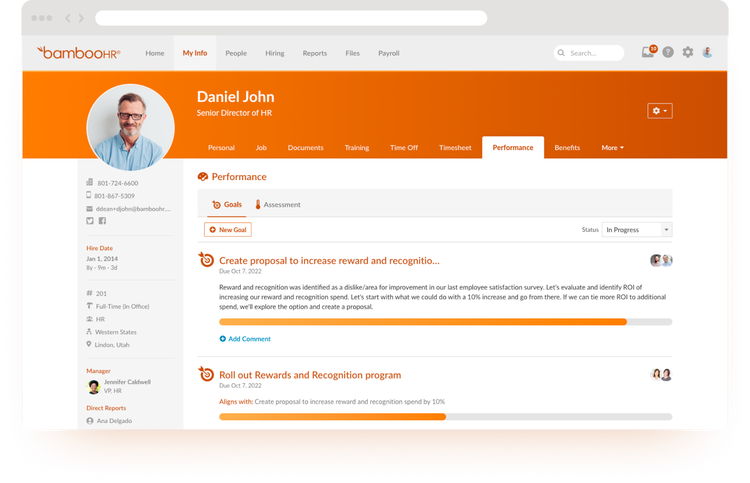
How Better Performance Reviews Drive Employee (and Company) Growth

Twenty-four percent! That’s a lot of people missing out on the chance to bring the full value of performance reviews to bear in their organizations. In this guide, we’ll put negative perceptions of performance management to rest and discuss the following:
- The true purpose and potential of performance reviews
- How to prepare a quality performance review
- Pitfalls to avoid when conducting reviews
- How quality reviews can help your people and company grow

What’s the Purpose of a Performance Review?
Modern performance reviews:
- Assess the employee’s strengths and weaknesses with the employee themself.
- Assist with goal setting, follow-through, and accountability.
- Provide feedback and direction that will actually be useful in the employee’s development of long-term, mutually beneficial skills.


Lack of career development and advancement is the top reason people quit a previous job between April 2021 and April 2022.
(Source: McKinsey & Company)
What Do Companies Really Get Out of Performance Management?

Leaders with an effective performance management process were almost twice as likely to consider it “crucial to business performance,” whereas naysayers seemed to be trapped in a self-fulfilling prophecy of low performance.
It’s not just that successful performance management practitioners have a different attitude than those who struggled to make their practice produce results. According to the survey, leaders with successful performance management processes get better results by implementing specific tools and methods to ensure maximum benefits across the organization.
- 2x as likely to use technology to a higher degree than manual processes
- More likely to have formal or substantial performance review conversations 4x a year or more
- More than 2x as likely to have a process that was easy for everyone to use
- More than 2x as likely to use upward ratings of supervisors
- More than 2x as likely to have deliberate PM training for their managers
- Buy-in matches effort (i.e., everyone’s on board and committed to continuous improvement).
- Easy-to-use technology lifts the manual burden and streamlines processes.
- Manager training prepares leaders to have quality performance conversations.
- Accountability for performance is a two-way street (i.e., supervisors are as much under the purview of performance reviews as employees).
People want coaches and allies, not taskmasters. They want regular, development-focused feedback instead of reductive yearly reviews that yield little more than a scorecard.


How Should People Leaders Prepare for a Performance Review?
According to SHRM, increased engagement—a predictor of high productivity—happens when employees “believe that their employer is concerned about their growth and provides avenues to reach individual career goals while fulfilling the company’s mission.”
People want to contribute to a mission they’re aligned with and grow their skills. In order to help them do both, assume your employees want to get the following out of their performance reviews and then prepare for the review with this in mind:
- Know exactly how their role matters
- Do meaningful work that has an impact
- Receive specific, constructive feedback on where they can improve
- Be acknowledged and rewarded for their efforts and successes

At a high level, your performance review process will follow these basic steps:
Set a Quarterly Cadence for Your Performance Review Cycles

Annual performance reviews began falling out of fashion in 2015, when a number of high-profile companies officially dropped the practice in favor of “continuous, real-time feedback.” So if once a year is definitely not enough, then what’s the right frequency? The short answer is it depends on your organization and your employees.
As an example, the top performers in HR.com’s 2021 performance management research were twice as likely than low performers to conduct formal reviews four times a year or more. When project goalposts call for it, it can be useful to conduct check-in style reviews as often as weekly, but the standard we recommend for formal, development-focused performance reviews is once every business quarter.
Build a Performance Review Template that Covers These Four Points
Following a template helps your performance reviews stay consistent and keeps the feedback relevant. And providing one for your people to follow makes it easier to compare apples to apples when analyzing the results to assess engagement, progress, and other aspects of performance.
This doesn’t mean your performance management has to be one size fits all. Alongside the standardized template, managers can take additional ownership of how they coach their departments with questions targeted to on-the-ground concerns. But whatever shape your company’s or individual manager’s performance review templates take, you’ll want to prompt the following feedback:
- Acknowledge wins and accomplishments
- Identify areas for development
- Give high-level feedback
- Give concrete and specific feedback

Help Set Specific, Realistic, and Actionable Goals

Performance reviews are a chance for managers to check in with employees about ongoing long-term goals, resolve quarterly goals, and set new ones. This goal-setting piece is absolutely crucial to get right—feedback helps employees see how they’re doing, but goals are how you help employees learn and find new ways to grow while becoming more effective contributors in the process.
The goals employees set with the help of their managers should be easy to measure and time-based, and should track with the trajectory of the employee’s career development path. This helps employees feel committed to each goal and motivated to achieve them.
Choose Action-Oriented Over Descriptive Performance Review Phrases

Dedicate at Least Three Hours of Preparation Time per Employee

- The individual’s peers via 360° feedback
- The individual themself via a self-assessment
Expect (and Encourage) a Two-Sided Conversation


Four Performance Review Pitfalls to Avoid
Don’t Spend Too Long on the Wrong Things
In an exhaustive performance management study conducted in 2017, Gallup’s chief scientist of workplace analytics concluded that organizations across the world were spending “tens of thousands of hours and tens of millions of dollars” on performance management-related tasks that were not only not working but were driving out top talent.
Today, a global pandemic and the rise of remote work has further complicated workplace productivity and the processes meant to track and increase it. In our experience, efficient and effective performance management happens when the systems you use cut out tedious manual work and streamline continuous performance management processes.

Don’t Let Too Much Time Lapse Between Reviews

Infrequent reviews lead to a slew of negative outcomes:
- A greater risk of recency bias: having recent events color performance perceptions for an entire year, for better or worse
- Less relevant feedback
- Emotionally charged dynamics
- Counterproductive results
When your people walk away from reviews feeling like they weren’t treated fairly or the guidance they received isn’t clearly applicable or actionable, you’ll end up with less engagement, not more. Again, we highly recommend a quarterly formal review cadence.
Don’t Allow Room for Bias to Creep In

Don’t Use Performance Reviews Purely for Wage Conversations

Performance reviews should provide an opportunity for growth, so it’s crucial to create the psychological safety needed to be open about weaknesses as well as strengths. However, when companies use performance reviews primarily to justify raises or promotions, the review becomes a high-pressure showcase as opposed to a place where employees, managers, and companies can find better alignment.
Performance intersects with compensation in varying ways, but when it comes to addressing each with your employees, it’s time to separate the two conversations. Your compensation strategy deserves its own procedural track, as does a robust growth and development plan.

How Performance Reviews in BambooHR Set the Stage for Employee and Company Growth
In a 2022 survey of BambooHR customers conducting performance reviews, respondents were more likely to say they had an effective performance review process if they were using BambooHR® Performance Management compared to any other type of review process.
One of the top reasons for this is our system’s intuitive automation of operational tasks like scheduling, feedback submission, data reporting, and more, which makes the meaningful work of continuous performance management less about process and more about purpose for everyone.
How BambooHR Empowers HR

“The more enlightening piece of Performance Management is seeing how we can really identify what are the strengths and weaknesses. We can build upon the strengths and then we obviously still have time for the weaknesses but maybe we approach it in a different way.”
Neil Sharma | VP of Operations | Boston BioProducts
The results Becky has been able to achieve echoes those of over 11,000 other companies using BambooHR Performance Management and their hundreds of thousands of employees, with 95 percent using our advanced goal-setting and tracking feature to help drive engagement and performance.
Here are some other ways BambooHR Performance Management drives results:
- Double blind assessments mitigate bias and subjective rating systems.
- Impromptu and skip assessments help managers coach employees when and how they want.
- Advanced goal-setting with file upload (i.e., sharing, updating, closing goals, etc.) provides structure, direction, context, and accountability for development.
- Custom Likert rating scale produces clear, actionable data to track.
- 360° peer feedback paints a multi-perspective picture of an individual’s performance.
- Up to 10 custom assessment questions let you tailor additional questions to current initiatives or your company’s unique needs.
- Multiple review cycles provide added flexibility in how you manage performance across teams.
How BambooHR Empowers Employees

Employee Satisfaction with eNPS®*
Gather data on how your people view their growth potential at your company.

“[BambooHR Performance Management has] just opened up the dialogue, and that’s the most important thing—that people are actually talking.”
Becky Thompson | HR Director | Gravy Analytics





